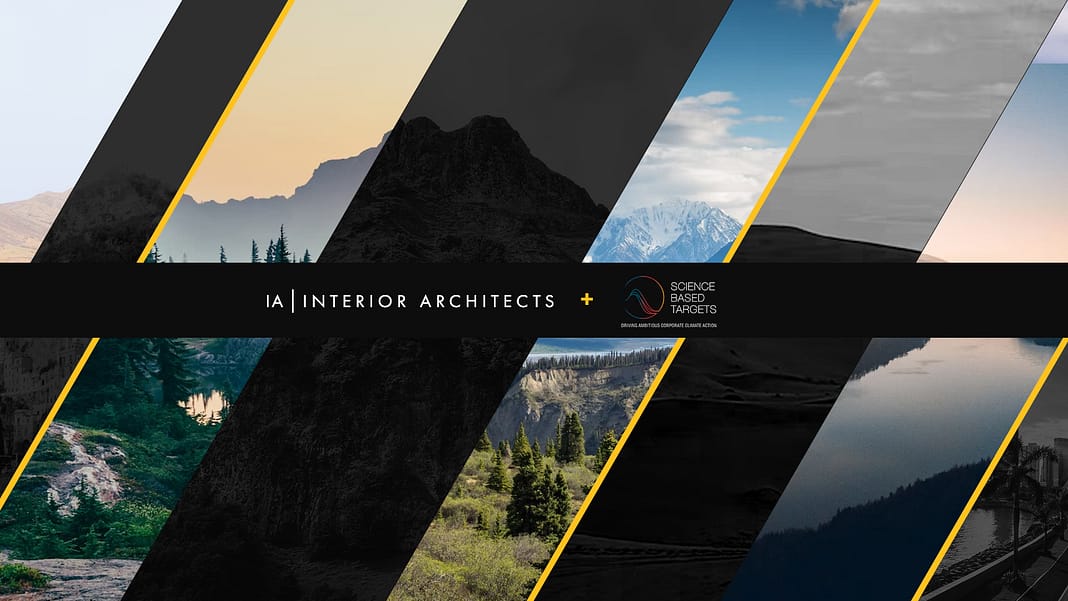Mary Lee Duff, LEED AP, IIDA | Director of Ecos Studio
&
Kirsten Menezes, LEED AP (O+M, ID+C), CBCP | Senior Project Manager

IA Interior Architects has signed on to the Science Based Targets initiative (SBTi), a commitment we’ve made with a compelling sense of responsibility—the stakes are high if the planet is to survive global warming. In line with Paris Agreement objectives, SBTi will provide a science-based process that verifies and measures IA’s progress towards publicly declared targets and timelines to reduce global warming. Considered the gold standard for measuring private sector emissions, SBTi offers a rigorous and trustworthy pathway for organizations to achieve valid greenhouse gas (GHG) reductions that supports two separate target programs: Near Term, encompassing 5-10 years, and Long Term to achieve NetZero no later than 2050. At this time, IA is the first architecture and design firm to join SBTI and commit to both targets. Of the many agendas IA has initiated to achieve our Environmental, Social, and Governance goals, joining SBTi is one of the most demanding and defining steps we can take that puts us squarely in the action to quell global warming before it is too late.
As a partnership between CDP (Carbon Disclosure Project), the United Nations Global Compact, World Resources Institute (WRI), and the World Wide Fund for Nature (WWF), SBTi is mobilizing the private sector to take the lead on climate action by bringing together a team of experts that provide participating organizations with independent assessment and validation of their yearly progress towards established, SBTI vetted science-based targets. Targets are deemed science-based if they align with the latest climate science to achieve Paris Agreement goals that limit global warming to well below 2 degrees Celsius above pre-industrial levels and limit warming to 1.5 degrees Celsius. Working with SBTi, organizations publicly declare, set, and monitor their targets via a clearly-defined course of action for reducing emissions and future-proofing sustainable business growth.
Target Setting
Target setting for IA and every participating organization is a step-by-step process tracked on the SBTI website:
- Commit – Register and submit a letter establishing the intent to set science-based targets.
- Develop – Within 24 months from commitment, identify emissions reduction targets in line with SBTi criteria
- Submit – Present targets to SBTi for official validation.
- Communicate – Announce targets; inform stakeholders.
- Disclose – On an annual basis, publicly report to SBTi the organization’s emissions reductions and progress towards targets.
SBTi lays out a five-step approach to set targets:
- Select a base year
- Calculate the organization’s emissions for that year
- Set target boundaries
- Choose a target year
- Calculate a target.
When setting targets, three types of emissions must be considered: Scope 1 and Scope 2 reference direct and indirect emissions from sources owned or controlled by the organization. Scope 3 references indirect emissions, not owned by the organization that fall into two categories: Upstream, which applies to the organization’s suppliers and Downstream, which applies to the organization’s customers. Upstream includes purchased goods and services; capital goods; waste generated by operations; upstream transportation and distribution; business travel; employee commuting; upstream leased assets; and fuel and energy related activities not included in Scope 1 & 2. Downstream includes transportation and distribution; the processing of solid products; use of solid products; end-of-life treatment of solid products; downstream leased assets; franchises; and investments.
Targets are set relative to a base line. IA’s baseline is 2019, the last year of normal operations before the pandemic’s impact. Discussions with IA operational teams and business units have identified categories within each scope that are material to our operations. Key stakeholders for those categories, for example our finance and travel departments, have provided relevant information via a form designed by Brightworks Sustainability, our strategic partner in creating and maintaining the IA Ecos Studio. As one of the first science-focused sustainable consulting firms in the US using advanced technical resources, Brightworks has collected the data and reviewed for completeness and quality assurance. Using that information and GHG Protocol Standards for calculation, our emissions for 2019 were identified.
Significant Percentages
Initial findings show that 29% of IA’s emissions fall under Scopes 1 & 2, representing direct and indirect emissions that we own or control. Breaking that down further, 6% are emissions from gas-based heating systems, and 23% account for the grid electrical use of our studios in the buildings IA occupies. Scope 3 emissions, indirect emissions that we do not control, account for 71%, representing purchased goods and services, including business travel.
Abatement Considerations
An array of practices and strategies will be required to reduce our emissions. To call out a few, a focus on green leasing for our studios will play a big part in reducing Scope 1 & 2 emissions. Energy efficiency and high-performance electrified buildings will be sought. Composting services will become more prevalent at our locations. As always, electronic documentation is preferable to paper and printing services. Renewable energy credits are another possibility.
Considering Scope 3, business travel makes up 31.78% of our emissions, the employee commute accounting for a significant 24.72%. All travel will be evaluated and minimized. Abatement strategies will include choosing urban environments for our studios that allow for alternative transportation. Providing bike storage and encouraging walking and carpooling, with the lure of incentives, will be other options.
For air travel, sustainable aviation fuel and its further development looks promising. We currently work with Tripadvisor to alert staff about lower-emitting flight options. Tripadvisor also calculates our carbon usage for all travel, including hotel stays and car rental, to help us track emissions.

Clout and Engagement
At both the client and designer level, the growing practice of pressuring partners and providers to focus on sustainability and reducing emissions is generating a chain reaction that will be a powerful factor going forward. Some clients now require that a commitment to sustainability with emissions accountability be written into engagement contracts with design partners and providers; others stipulate sustainable materials only be used in their projects.
As one of the largest specifiers of materials and products, we have a significant opportunity to reduce our Scope 3 emissions and impact climate change through the specification of sustainable materials and products in all project work. We will also ensure that all IA professionals understand current industry practices regarding product labeling and declarations around health and environmental impacts.
We work to meet sustainable criteria as designers. To remain competitive, manufacturers and supplies will have to ensure that their materials, practices, and production are sustainable, transforming the supply chain. Environmental accountability is increasingly required to do business. As our clients’ design partner, environmental considerations are factors in all our work. Going forward, IA’s sustainable procurement policy and purchasing strategies will focus on low-carbon suppliers for purchases and capital goods; vendors that report and act on data, reducing emissions and demonstrating accountability, will be given priority.
Emissions Reduction and the Endgame
SBTi tracking is pragmatic and unequivocal. IA’s emissions reductions will be measured using the Absolute Contraction Approach that establishes targets to reduce GHG emissions as set percentages reported in tons. We are now within the 24-month period to set target goals and currently working to establish those targets that will then be vetted by SBTi. We are on our way down a carefully constructed path towards Net Zero, and we hope others join us.

